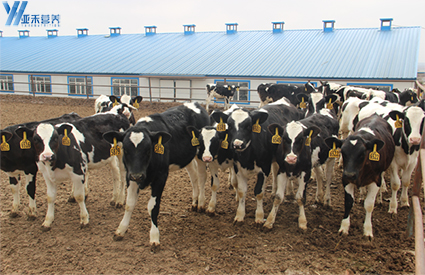The average winter temperature in the north of China is -6 ℃ ~ -8 ℃, and the lowest temperature can be below -30 ℃. The suitable temperature for cows is 5 ~ 21 ℃, therefore, the key task is to prevent or mitigate the impact of cold stress on the performance of dairy cows, including the temperature control of all aspects of the dairy farms, dietary nutrition control, and prevention of freezing damage.

(1) Cow house temperature: the most suitable temperature for ordinary cows is 12 ℃ ~ 14 ℃, and the most suitable temperature for pregnant cows and lactating cows is 16 ℃ ~ 20 ℃. If the temperature of lactating cow house is higher than 24 ℃ or lower than -4 ℃ , The milk production will be reduced; the most suitable temperature for calves is 35 ℃ ~ 38 ℃.
(2) Drinking water temperature: The drinking water temperature of cows in winter and spring is controlled at 8 ℃ ~ 15 ℃. If dairy cows drink cold water, it will increase the consumption of heat energy. Drinking cold water below 8 ℃, the milk production will be significantly reduced. The temperature of drinking water for calves is preferably 35 ℃ ~ 38 ℃, and the temperature of drinking milk for calves is 35 ℃ ~ 37 ℃ (colostrum 37 ℃ ~ 39 ℃).
(3) Milk cooling and storage temperature: cooling to below 4 ℃ within 2 hours after the milking; the storage temperature of the refrigeration tank is kept at 4 ℃, and the storage time is not more than 48 hours; the whole temperature of the milk tanker transportation is controlled below 4 ℃
(4) Sterilization temperature of milking equipment: the temperature of clean water is 38 ℃ ~ 43 ℃ during pre-rinsing, the starting temperature of alkaline cleaning solution is 70 ℃ ~ 80 ℃ during alkaline cleaning, and the starting temperature of acid cleaning solution during pickling is 33 ℃ ~ 43 ℃ .
(5) Thawing temperature of frozen sperm: When the frozen sperm is thawed, the temperature of the water bath is 35 ° C to 36 ° C.
2. Dietary Nutrition Adjustment
Under cold stress conditions, cows consume their own energy to maintain body temperature, so the amount of energy feed must be increased in winter cow diets (increased by 10% to 15%). According to Liu Defang et al. (1998), cows consume 32% more maintenance energy at -20 ° C, and 37% more maintenance energy at -30 ° C. Wang Hongrong et al. (2009) believed that in order to increase the energy level in feed, increasing the proportion of concentrated feed and adding fat has drawbacks. It is recommended to add rumen bypass fat to the cow's diet or rumen bypass glucose to ensure the cow's energy supply.
Appropriately increase the amount of calcium, phosphorus, salt, vitamins and trace elements in the diet. Cows in the cold season are prone to lack of vitamin A and vitamin E so it should pay attention to the addition of these two vitamins. The feeding amount can be doubled, or rumen vitamins can be fed to ensure the cows' vitamin requirements. Dry matter in TMR is controlled from 53% to 54%, and it is required to be produced indoors to reduce exposure time outdoors and prevent freezing.
3.Prevention of frost damage
Low temperature and high cold weather can easily cause frost damage to cows, causing frostbite of their nipples, which will seriously affect the normal survival of cows. Frost damage to lactating cows will reduce milk production, sexual performance, conception rate and even no estrus. Calves will suffer from rheumatism, arthritis, diarrhea and other diseases.
The dairy farms can ensure the warmth of the cowshed, increase the energy level of the diet before entering the winter, and supplement the cow's fat to improve the cow's own resistance to the cold. After entering the winter, repair the hoof of the cow in time, increase the light and exercise; scientific crowding milk, proper concentration of the medicinal bath solution: there must be enough iodine and glycerin in the medicinal bath solution, the medicinal bath should be sufficiently thorough to prevent nipple frostbite. Do a good job of cleaning the body of the cow, increase the number of brushing the cow body to promote blood circulation, enhance the ability to keep out the coldness; purchase some products specially used for dairy cows' antifreeze and warmth protection and health care, such as cows' bras, calves' coldproof warmth vests, etc.


.jpeg)

.jpeg)
